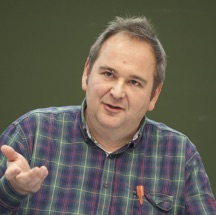


Many modern fields of chemistry, physics and Materials Sciences, as heterogeneous catalysis, nanosieving, and gas storage, require computer simulations for the general understanding of their structure, dynamics and reactivity. The accurate description of weak interactions is a necessity to achieve this coal. A substantial part of the interaction energy arises from van-der-Waals and electrostatic contributions.1,2 The entropy contribution to the free energy is usually important, and popular approximations to address this quantity are not always suitable.3,4 [1] L. Zhechkov, T. Heine, S. Patchkovskii, G. Seifert, and H. A. Duarte, J. Chem. Theory Comp. 2005, 1, 841-847. [2] T. Heine, L. Zhechkov, and G. Seifert, Phys. Chem. Chem. Phys. 2004, 6, 980-984. [3] S. Patchkovskii, J. Tse, S. Yurchenko, L. Zhechkov, T. Heine, G. Seifert, Proc. Natl. Acad. Sci. USA 2005, 102, 10439-10444. [4] S. Patchkovskii and T. Heine, to be submitted to Phys. Chem. Chem. Phys., invited paper. [5] F. Schönborn , H. Schmitt , H. Zimmermann , U. Haeberlen, C. Corminboeuf , G. Großmann and T. Heine, J. Magn. Res. 2004, 175, 52-64. [6] T. Heine, C. Corminboeuf, G. Grossmann, U. Haeberlen, Angewandte Chemie (2006), in press. [7] L. Zhechkov, A. Kuc, S. Patchkovskii, G. Seifert, T. Heine, submitted to Nano Letters (2006). [8] L. Zhechkov, S. Patchkovskii, G. Seifert, T. Heine, in preparation.  Left: H shielding tensor in solid benzene:The shielding of proton H2 is given in the single molecule and in the>crystal in ellipsoid representation. Right: Interaction potential of C60 intercalated graphite with H2.
Left: H shielding tensor in solid benzene:The shielding of proton H2 is given in the single molecule and in the>crystal in ellipsoid representation. Right: Interaction potential of C60 intercalated graphite with H2.
In this lecture I will discuss the principle interactions from first-principles. I will show consequences for the simulation of properties, e.g. of solid-state NMR in van-der-Waals crystals.5,6 Further, I will present a simple but accurate method to compute the free interaction energy of guest-host-systems where the guest molecules are only bound by physisorbtion.3,4 The method will be applied to determine the capacity of carbon nanostructures to store molecular hydrogen.3,7,8



Many modern fields of chemistry, physics and Materials Sciences, as heterogeneous catalysis, nanosieving, and gas storage, require computer simulations for the general understanding of their structure, dynamics and reactivity. The accurate description of weak interactions is a necessity to achieve this coal. A substantial part of the interaction energy arises from van-der-Waals and electrostatic contributions.1,2 The entropy contribution to the free energy is usually important, and popular approximations to address this quantity are not always suitable.3,4 [1] L. Zhechkov, T. Heine, S. Patchkovskii, G. Seifert, and H. A. Duarte, J. Chem. Theory Comp. 2005, 1, 841-847. [2] T. Heine, L. Zhechkov, and G. Seifert, Phys. Chem. Chem. Phys. 2004, 6, 980-984. [3] S. Patchkovskii, J. Tse, S. Yurchenko, L. Zhechkov, T. Heine, G. Seifert, Proc. Natl. Acad. Sci. USA 2005, 102, 10439-10444. [4] S. Patchkovskii and T. Heine, to be submitted to Phys. Chem. Chem. Phys., invited paper. [5] F. Schönborn , H. Schmitt , H. Zimmermann , U. Haeberlen, C. Corminboeuf , G. Großmann and T. Heine, J. Magn. Res. 2004, 175, 52-64. [6] T. Heine, C. Corminboeuf, G. Grossmann, U. Haeberlen, Angewandte Chemie (2006), in press. [7] L. Zhechkov, A. Kuc, S. Patchkovskii, G. Seifert, T. Heine, submitted to Nano Letters (2006). [8] L. Zhechkov, S. Patchkovskii, G. Seifert, T. Heine, in preparation.  Left: H shielding tensor in solid benzene:The shielding of proton H2 is given in the single molecule and in the>crystal in ellipsoid representation. Right: Interaction potential of C60 intercalated graphite with H2.
Left: H shielding tensor in solid benzene:The shielding of proton H2 is given in the single molecule and in the>crystal in ellipsoid representation. Right: Interaction potential of C60 intercalated graphite with H2.
In this lecture I will discuss the principle interactions from first-principles. I will show consequences for the simulation of properties, e.g. of solid-state NMR in van-der-Waals crystals.5,6 Further, I will present a simple but accurate method to compute the free interaction energy of guest-host-systems where the guest molecules are only bound by physisorbtion.3,4 The method will be applied to determine the capacity of carbon nanostructures to store molecular hydrogen.3,7,8
